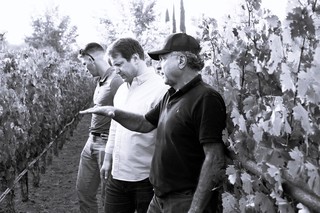By Antonio Galloni
I have long believed that all the world's great wines are wines of place. About a dozen years ago, two key events profoundly changed how I think about Napa Valley and its wines. The first of these was being asked by Robert Parker to take over coverage of California wines for him. As I drove around Napa Valley, I suddenly realized how few vineyards were clearly marked. Then, during the 2011 harvest, I observed vastly different conditions from place to place. Vineyards on the valley floor were wet and fogged in, while those at elevation basked in sunshine and warmer weather. These two events showed me that Napa Valley was an incredibly diverse region, but I also realized that there were no tools to explore and understand these myriad nuances like those that exist in many other regions around the world. That is when I decided I would embark on a project to map the vineyards of Napa Valley.
My objective was to create maps for Napa Valley with the same meticulous detail as those that exist for Burgundy, Piedmont and other regions. I had dabbled in maps before, but I knew I needed a partner for this project, a skilled cartographer, someone who could help me realize my vision. There was only one person on my list, and that was Alessandro Masnaghetti, the Italian cartographer who created the maps of Piedmont, Chianti Classico and other regions that are considered modern-day reference points. In 2015, Alessandro and I, along with our team at Vinous, embarked on our project to map Napa Valley and its nested AVAs (American Viticultural Areas).
The learning started immediately. Our many trips to Napa Valley revealed what I had already started to see: that Napa Valley is a region of astonishing complexity. For most visitors, Napa Valley is defined by vineyards that are visible on the valley floor and the many wineries and tasting rooms that lie along Highway 29 and the Silverado Trail. Beyond that, there is so much of Napa Valley that is tucked away into the hillsides, far out of sight of the casual visitor. Spending time in these vineyards led me to conceptualize Napa Valley as a sort of five-lane highway composed of the Mayacamas Mountains to the west and the Vaca Mountains to the east, both leading down to two connecting benches that converge onto either side of the true valley floor. It turns out much of Napa Valley is not really a valley after all.
Delving deeper reveals untold shades of complexity within each AVA and from appellation to appellation. Somewhat paradoxically, the coolest AVAs in Napa Valley are in the south, where greater proximity to the San Pablo Bay and its cooling air currents plays an important role in shaping those microclimates and the wines. Elevation is another important factor in understanding Napa Valley. Temperatures generally become cooler at higher elevations, but above the fog line, the relationship of light and temperature changes dramatically such that high-elevation sites are often marked by unique conditions that feature narrower diurnal temperature shifts than those found on the valley floor. All these nuances are ultimately reflected by what we taste in the glass, which is why unlocking the secrets of Napa Valley through maps remains such a passion.

Vinous Maps are a product of countless hours visiting vineyards and speaking with a wide range of professionals, including owners, winemakers, vineyard managers, geologists and soil scientists. The fronts of the maps are designed to show each AVA in painstaking detail, vineyard by vineyard, with vivid topographical detail that has never been available before. The backs contain rich histories of each appellation, descriptions of key vineyards and in-depth case studies of historically significant sites. These are the most in-depth maps ever created in the history of the Napa Valley. So far, we have published nine Napa Valley maps and have several more in the pipeline.
Our maps have played a role in highlighting the diverse characteristics of Napa Valley's vineyard sites. By visually representing the variations in terroir, these maps have opened the door to a deeper understanding of the region's unique qualities and their interrelation. We are currently witnessing a golden age for Napa Valley wines, sparking a significant global interest that was absent even as recently as a decade ago. Wine enthusiasts worldwide recognize the importance of wines being linked to a specific place. When California wines are associated with identifiable vineyards known for their distinct characteristics and nuances, their appeal to a global audience skyrockets.



